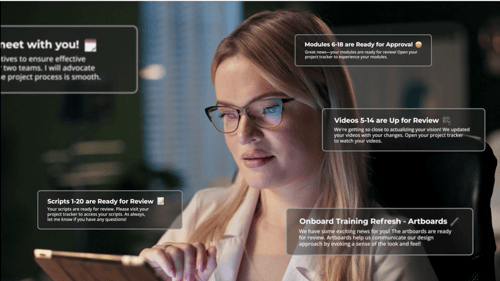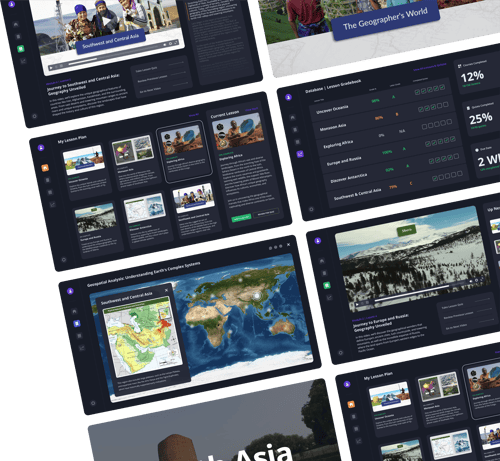In 2016, Dan Meyer shared the Desmos guidelines for building great digital math activities. The Desmos curriculum is still widely used today, recently earning a perfect score from EdReports.
These guidelines offer ways to design a wide variety of effective digital learning content. They also align nicely with the design principles we promote through our work in creating innovative learning experiences. These help achieve learning objectives through optimally designed e-learning courses - making video content achievable and successful.
With that context, we thought it would be helpful to adapt the Desmos guidelines to address the broader design requirements for digital learning content. Through content creation, the Desmos guidelines can be adapted to help students interact and improve online learning techniques. Here are six suggestions to guide your work:
1. Contextualize learners by creating an intellectual need for information and skills

We often design learning content by leading with the information we want participants to know. We are well-intentioned in doing this. We want to establish clear definitions and create a shared understanding of the task at hand. We want to ensure that the learner knows what they need to know – i.e., what we need them to know. This linear model occurs because we design learning the way we experience learning. Through cause-and-effect, precise definitions, and parameters, we hope to impose the same kind of rigorous structure we experienced.
This method of presentation usually deprives learners of context and removes their ability to engage freely with the learning courses. They are set adrift in training materials, told something is important instead of truly understanding why. They often have no idea why it’s necessary or how knowing about it makes a difference in their professional or personal lives.
Instead of leading with information, we should think about beginning our learning sequences with context – we should ask how we can help participants experience what they need. We should facilitate reflection that creates a personal context for the information. Interactive learning begins with association, relationships, and curiosity, so the students want to seek out information for themselves.
It’s easier to get learners more invested in the “what” by starting with the “why.”
2. Design learning content on a trajectory of informal to formal
It seems we’re always in a hurry to “get to the point” with our learning content. Instructional designers create training materials with clear objectives in mind and then design the course to meet those objectives. We want to get the “right answer,” the formal version of our information, in front of learners straightaway. Once we’ve established that foundation, we’ll move directly to practical application and discussion.
The challenge with this approach is that it eliminates opportunities for deeper, more effective learning – a genuine, self-motivated inquiry about our information. Often, we present the correct answers before even allowing the opportunity to think about other possibilities and why they’re not the formal answers we’re aiming for. Giving the “right answers” up front makes it more challenging to interest learners in speculation or thinking outside traditional boundaries. Talent education should be about developing critical thinking skills and adaptive learning techniques, not regurgitating facts that someone else dictated.
A more successful approach is to start with an informal, no-right-answer inquiry and gradually move toward formal definitions and explanations. Begin with hypothetical scenarios. Ask for situational conjecture. Present a small fragment of your information and have learners discuss its implications without knowing the full context. Invite them to discover and explore before formalizing the experience. This is especially important in eLearning content because it can be easy for students to skip to the end of videos, courses, and even entire modules.
3. Maintain a constant view of the Big Picture
Everyone agrees that segmenting content into smaller chunks is a good practice when developing digital learning content. To create effective eLearning content, you need to give the learner the ability to process all the information you’re giving them. Whether the content delivery method is learning with video, reading, or an activity, we want to create focused, easily digestible content experiences.
While segmenting content into granular, focused pieces is good, it can also lead to a loss of the Big Picture. Participants can quickly lose sight of why the specific information or skill they are learning matters - They forget where it fits into the grand scheme.
In other words, we want to keep learners contextualized throughout all their learning experiences. When presenting an activity or chunk of information, we should remember to insert Big-Picture reminders or reference points.
Context is essential at every stage of the online learning process. Build content that has consistent reminders of the overarching themes and how the bits of knowledge they’re learning contribute to it.
4. Design learning content to foster collaboration and conversation
Learners often work asynchronously at their own pace when they engage with digital content. That makes it easy to forget about designing for collaboration and conversation.
With this in mind, we want to look for opportunities in our content design to ask reflection questions to stimulate personal inquiry and conversation. We want to stimulate participant thinking with questions that generate genuine conversations beyond reciting the correct answer.
As the Desmos team points out, we want to:
Maximize the ratio of conversation time per screen, particularly in concept development activities. All other things being equal, fewer screens and inputs are better than more. Ring the gong if one screen is extensible and interesting enough to support ten minutes of conversation.
This can be done by designing informational videos that stimulate this way of thinking.
5. Take advantage of and test apperceptive mass
According to the Merriam-Webster Dictionary, apperceptive mass is "the whole of a person's previous experience that is used in understanding a new [insight] or idea."
As subject matter experts, we generally create learning content from the perspective of a “knower” sharing information with someone who is an “unknower.” In other words, we treat our learners like homogeneous blank slates onto which we will impart a specified quantity of data. An effective subject matter expert treats this task without arrogance and condescension, usually through more interactivity and engaging questions that facilitate conversation.
Taking this approach overlooks the fact that our learners have already amassed a great deal of professional and personal knowledge. They have developed an apperceptive mass that is incredibly valuable in processing and understanding new ideas. Though we have the authoring tools to give them information we think they need, they receive and process through the lens of their experiences and the context that allows them to learn new concepts.
When working with adult learners, particularly groups who share an interest or concern, we can design our content to take advantage of apperceptive mass and create profoundly engaging and impactful learning experiences. With such groups, it’s vital to help learners test the limits of their previous experiences when drawing conclusions or making intuitive leaps.
6. Make it easy to interact and play
Our professional experiences tell us that providing easy points of entry into a task increases the likelihood that people will persist with and perform the task well. Participants don’t mind if a task becomes incrementally more complicated if they can start the process and get up to speed with relative ease.
The same holds true with learning design. We want to make it easy for participants to engage with our content. Information and skill development may increase in difficulty later, but the beginning should always be easy.
Wherever possible, we want to make the experience playful through interactivity and experimentation. Allow learners room for exploration. Let them play with the ideas first, without consequences or concerns about being wrong, before moving into more formal instruction.

NextThought team
NextThought transforms workplace learning through creative technology and engaging media. We're fortunate to partner with some of the top organizations in the world to make their educational training content remarkable and effective.
Recent Posts

What Can Go Wrong With A Custom Training Project? (And How NextThought Makes It Go Right)
August 5, 2025 1 Min Read

How Much Does a Custom Content Development Project Cost?
July 9, 2025 3 Min Read

The 6 Best Educational Video Production Companies (2025)
February 28, 2025 9 Min Read

